Field Trip to Okinawa
November 23-27, 2010
Organizers:
Kenichi Matsui (University of Tsukuba) and Shisei Toma (Association of Indigenous Peoples in the Ryukyus)
Participants:
Dr. Milton Kanashiro (EMBRAPA East Amazon), JDS students from Vietnam and the Kyrgyz Republic at the University of Tsukuba
Outline:
This field trip aimed to better understand the traditional culture and history of Okinawa Island along with its distinctive ecosystem. The entire trip was guided by Mr. Shisei Toma, who is one of representing members of the Association of Indigenous Peoples in the Ryukyus (NPO). Dr. Milton Kanashiro was invited from Brazil. He is an expert on the tropical forest and the second generation Okinawan Brazilian. JDS students are those who are under the funding of the Japan International Cooperation Agency (JICA) and belong to the Environmental Sciences Program at the Graduate School of Life and Environmental Sciences, the University of Tsukuba.
Schedule:
| Date | Places | Description of Activities |
|---|---|---|
| Nov. 23 |
|
|
| Nov. 24 |
|
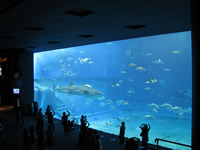 Our visit to the world renowned aquarium helped us better understand the intricate marine ecosystem in Okinawa along with mangrove forests. Our visit to the world renowned aquarium helped us better understand the intricate marine ecosystem in Okinawa along with mangrove forests. Kouri Island is located just off the coast of Nago City. Most people live on pineapple or sugar cane farming along with sea salt production. Nago Pinapple Park provides a tour of pineapple plants and lots of opportunities to shop. Pineapple canneries used to be one of the major industries in the 1950s and 1960s, thanks to those immigrants from Taiwan who brought their skill and labor to Okinawa. Mr. Toma invited Drs. Kanashiro and Matsui to his traditional meeting called “Mo-Ai,” where local people from many age groups gather and discuss informally issues that concern them. |
| Nov. 25 |
|
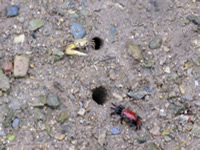 The Botanical Garden provides an overview of the Okinawa ecosystem, including plants/ flowers, insects, and fish. The Botanical Garden provides an overview of the Okinawa ecosystem, including plants/ flowers, insects, and fish. 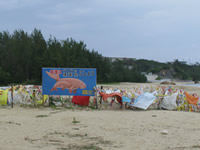 Our visit at Henoko Bay was to better understand the issue surrounding the Futenma Replacement Facility that was scheduled to be established in Henoko Bay. Local people and many environmental activists oppose this plan largely because the bay nurses dugongs that are culturally important. We had a speaker from this area who proposes to establish a marine protected area here. Our visit at Henoko Bay was to better understand the issue surrounding the Futenma Replacement Facility that was scheduled to be established in Henoko Bay. Local people and many environmental activists oppose this plan largely because the bay nurses dugongs that are culturally important. We had a speaker from this area who proposes to establish a marine protected area here. 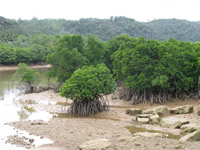 The mangrove forest at Kesashi is the largest in the main island. This forest has three mangrove species, and we tried to identify these. The forest also is the habitat for fish and crabs that are distinctive here. The mangrove forest at Kesashi is the largest in the main island. This forest has three mangrove species, and we tried to identify these. The forest also is the habitat for fish and crabs that are distinctive here. |
| Nov. 26 |
|
The historic site, “Chibichiri-Gama,” was a natural cave used as a shelter for a few hundred local Okinawans during World War II. The coast very close from this place was the site where American troops landed first to fight against the Japanese Army on the main island of Okinawa. Local people in the shelter were told that Americans were monsters and would kill, rape or eat them at the discovery of the Okinawan people. Many in the cave, who were women or children, believed it and killed themselves. We had Mr. Shoichi Chibana, an expert on the history of this historic site, spoke to us about this sad history.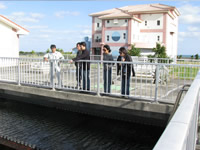 The water treatment plant is one of unique facilities in Japan, where they introduced specially treated soil with bacteria that absorbs smell that comes out from waste water. This method sounds like more economically viable compared to using active carbon. The water treatment plant is one of unique facilities in Japan, where they introduced specially treated soil with bacteria that absorbs smell that comes out from waste water. This method sounds like more economically viable compared to using active carbon. The Association of Indigenous Peoples in the Ryukyus (AIPR) hosted the last night gathering. Young members joined us in a restaurant within the American military base. Our discussion included the future of Okinawa and traditional knowledge. |








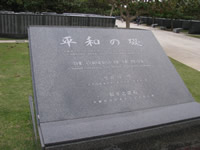 These places gave us a glimpse into the history of Okinawa during World War II. Some Vietnamese students found the history similar to that of Vietnam.
These places gave us a glimpse into the history of Okinawa during World War II. Some Vietnamese students found the history similar to that of Vietnam.